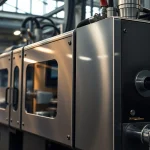
Understanding Blow Molding Technology
What is Blow Molding?
Blow molding is a manufacturing process that shapes plastic into hollow parts by inflating a heated plastic tube (parison) inside a mold. This innovative method allows for the production of a variety of plastic products, including bottles, containers, and even sophisticated automotive parts. The process is highly efficient, catering to mass production needs while maintaining high precision. An essential aspect of blow molding is the versatility it offers in creating complex shapes, making it an integral part of modern manufacturing.
Types of Blow Molding Processes
There are primarily three types of blow molding processes, each tailored for specific applications:
- Extrusion Blow Molding (EBM): In this process, plastic is melted and extruded into a tube before being inflated in a mold. EBM is popular for producing containers and bottles, offering flexibility in design and size.
- Injection Blow Molding (IBM): This method combines injection molding and blow molding. First, a preform is created using injection molding, then it is transferred to a blow mold where it is inflated to form the final product. IBM is ideal for producing small and intricate parts with high precision.
- Stretch Blow Molding (SBM): This technique involves stretching the preform during the blow molding process, enhancing the material’s strength and clarity. SBM is commonly used for manufacturing PET bottles, particularly in the beverage industry.
Applications of Blow Molding in Industries
The applications of blow molding span across various industries, showcasing its versatility and efficiency:
- Packaging Industry: The production of plastic bottles for beverages, personal care products, and household goods dominates this segment. With growing sustainability concerns, manufacturers are now exploring recycled materials and biodegradable options.
- Automotive Sector: Components such as fuel tanks, air ducts, and other hollow parts are produced using blow molding due to their lightweight properties, which contribute to enhanced fuel efficiency.
- Toys and Household Products: Many consumer products, including toys, storage containers, and more, leverage blow molding techniques for their economical production and design flexibility.
- Medical Devices: Certain applications in the medical field, requiring high precision and safety, are catered to by advanced blow molding technology.
Why Choose a Reputable Blow Molding Machine Manufacturer?
Evaluating Manufacturer Experience and Track Record
Choosing a reliable blow molding machine manufacturer is crucial for ensuring production efficiency and quality. An established manufacturer typically has a proven track record, leveraging years of industry experience that can translate into better product reliability and customer service. It’s also advisable to assess their history of partnerships and major projects completed, as these indicators can provide insights into their operational capabilities and expertise.
Importance of Quality and Reliability
Quality assurance is vital in blow molding processes due to the direct correlation between machine reliability and product performance. A reputable manufacturer will invest in rigorous quality control measures, including material testing, machine calibration, and compliance with international standards. This commitment not only guarantees the performance of the blow molding machines but also contributes to minimizing downtime and maintenance costs for users.
Innovations in Blow Molding Machinery
Innovation is at the heart of competitive manufacturers. The emergence of Industry 4.0 has led to the integration of smart technologies in blow molding machines, enhancing automation and data analytics. Manufacturers are now offering machines equipped with IoT capabilities which allow real-time monitoring of production processes for vastly improved efficiency and quality control. Additionally, advancements in material science, such as the use of bioplastics, are becoming increasingly common in modern blow molding machines.
Key Features to Look for in Blow Molding Machines
Efficiency and Speed
The production speed of blow molding machines is a critical feature that directly impacts operational efficiency. Advanced machines are designed to optimize cycle times while ensuring minimal energy consumption. When evaluating a blow molding machine, consider its output rate per hour, as well as the efficiency of its blow molding process. Manufacturers that can offer higher speeds without compromising quality can significantly enhance your production throughput.
Ease of Maintenance and Operation
A user-friendly interface and ease of maintenance are essential for maximizing production uptime. Look for machines that offer comprehensive documentation, training programs, and accessible support. Innovative designs with fewer parts can also simplify the maintenance process, reducing labor costs and machine downtime significantly.
Customization Options for Diverse Needs
Customization enables manufacturers to adapt machines to specific production needs. Many producers require tailored solutions for unique products, which calls for flexibility in the equipment. A reputable manufacturer should offer modular designs that allow for quick adjustments in tooling and configurations, ensuring the machines can handle various job requirements seamlessly.
Comparing Top Blow Molding Machine Manufacturers
Market Leaders in the Industry
The blow molding machine industry is populated by several key players known for their reliability and product quality. Brands like Uniloy, Wilmington Machinery, and Jomar Corporation lead the market, offering diverse machine options under various technologies. They showcase their capabilities through consistent innovation and adaptation to emerging market requirements.
Cutting-Edge Technologies Offered
Manufacturers competing in this space continuously explore the latest technological advancements. For example, some offer hybrid blow molding machines that combine the features of both injection and extrusion techniques to increase efficiency and product quality. Another notable development is the integration of automation and smart manufacturing technologies, allowing users to connect machines to a centralized monitoring system for real-time data analytics.
Customer Support and After-Sales Services
Robust customer support is a hallmark of leading blow molding machine manufacturers. Evaluate potential suppliers based on their after-sales services, including installation support, maintenance programs, and warranty options. Superior customer service can ensure that you receive comprehensive support throughout the life cycle of your machine, minimizing potential downtimes and maximizing productivity.
Investment and Cost Considerations
Understanding Price Structures
The initial cost of a blow molding machine can vary widely depending on the technology, features, and manufacturer reputation. It’s essential to understand the complete pricing structure, including installation, operational costs, and ancillary equipment needed for full functionality. Potential buyers should conduct a thorough cost-benefit analysis to assess the long-term investment perspective.
Long-Term Value and ROI of Blow Molding Machines
Investing in a high-quality blow molding machine can yield significant returns over time. Factors affecting ROI include decreased production costs, improved product quality, and reduced operational downtime. A machine that enhances production efficiency can directly impact profit margins and position a business competitively in the market. Companies should keep track of production metrics post-purchase to continue evaluating machine performance against initial expectations.
Financing Options for Businesses
Many manufacturers offer financing solutions to facilitate investments in blow molding equipment, recognizing the substantial initial capital requirement. Options may include leasing arrangements, installment payments, or financing through external financial institutions. Understanding these options can enable businesses to acquire the necessary equipment without straining their operating budgets.







